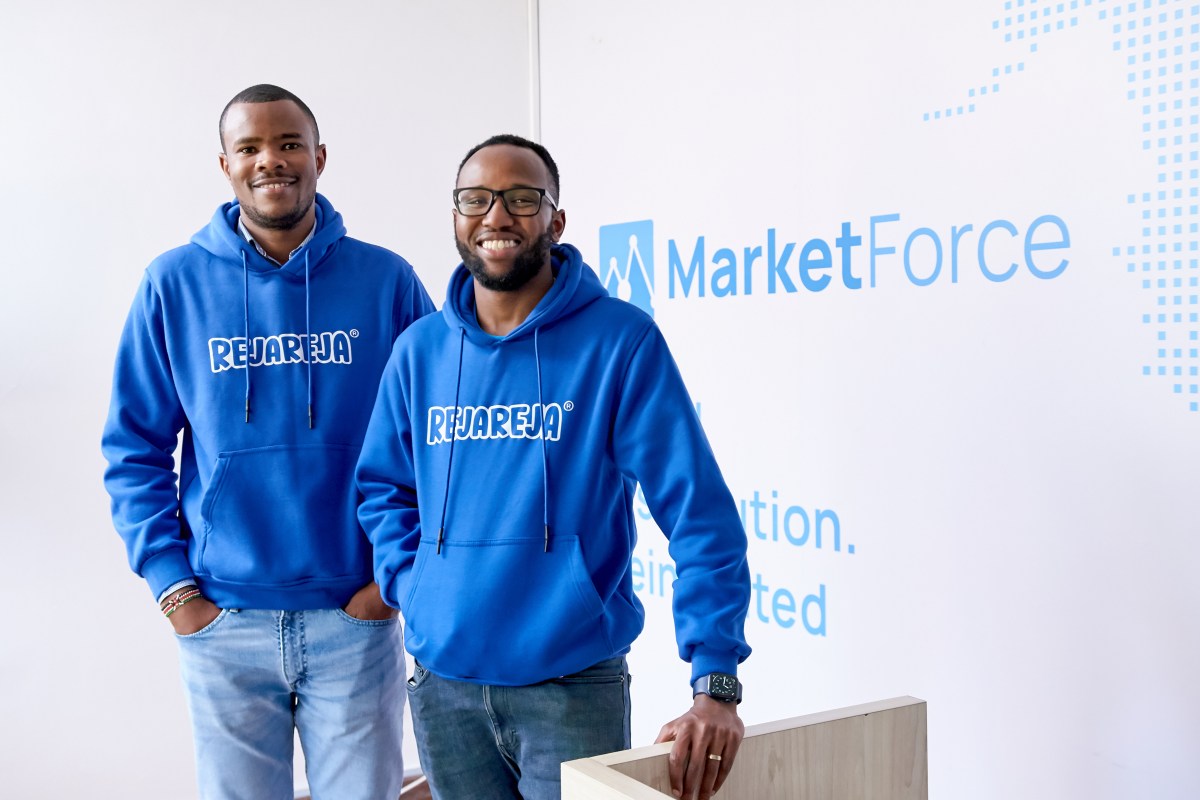MarketForce forced to tighten its belt as tough times hit
MarketForce, a Kenyan B2B e-commerce platform, had the ambitious plan of growing the number of informal merchants sourcing FMCGs from its platform by over a million by end of 2022, laying the ground for it to reach millions more in the years to come.
The startup’s co-founder and CEO, Tesh Mbaabu, made these plans known to TechCrunch after closing a $40 million Series A funding, half of which was equity.
However, months after, MarketForce’s plans seems to have been thrown in disarray with some of the VCs that committed funds in the round backing out of the deal, sending it out to look for new investors at a time when capital has become elusive.
It was not immediately clear why and which investors backed out of the deal; however, TechCrunch has learnt that of the $20 million equity, $8 million was never wired “due to failed capital calls on their (investors) side,” Mbaabu said.
This forced it to slow down its growth plans, and downsize. The company is not out of the woods as it finds it hard to meet operating expenses including staff salaries, and obligations to its suppliers.
However, Mbaabu is banking on anticipative conversations he is holding with investors, and the company’s new path to profitability, for a quick turnaround.
Founded in 2018 by Mbaabu and Mesongo Sibuti, MarketForce’s wait for meaningful capital injection comes at a time when the VC investment frenzy seems to be dying down in Africa, judging by the decline in deal count and value in Q1.
This is in contrast to last year, when the funding market was on an upward trajectory. Indeed, the e-commerce sector in Africa was among the top three sectors with the most funding attention in 2022, when the continent raised record capital amid falling global VC backing.
E-commerce raised $638 million, according to Partech data, over 124% growth when compared to the previous year when B2B e-commerce platforms like Twiga, and TradeDepot raised huge rounds.
However, despite raising huge funding, B2B e-commerce startups like MarketForce have been forced to scale back in the wake of new funding realities. Others that have had to downsize include Twiga, Copia, and Alerzo.
MarketForce is tapping the informal retail sector in Africa, which accounts for about 80% of household trade in sub-Saharan Africa. Informal merchants in the region are faced with a myriad of challenges like stock-outs, earnings instability and lack of financing, all of which hamper the growth of their businesses.
The startup is solving this by enabling informal traders to order goods for next-day delivery directly from its merchant’s super-app dubbed RejaReja. Traders are also able to access goods on credit based on the history of their transactions and credit profiles.
TechCrunch caught up with Mbaabu to learn about, among other things, how his company is operating amidst the cash crunch, and how its partnerships with the Kenyan government is rubber stamping the relevance of its distribution model.
(Editor’s note: The interview has been edited for clarity and brevity.)
There is so much talk of a market reset, founders finding it hard to raise funds as fast as it happened before, startups facing cash crunches, and many having to scale down or adapt to survive. How has it been for MarketForce?
It’s been a rollercoaster.
This reset has brought everyone back to thinking about the fundamentals, which I think is good. That’s what we’ve been doing the last couple of months, and making a number of hard decisions. We have had two rounds of layoffs and it’s not been easy.
We raised funds to expand into more markets (currently operate in five markets), but, initially, we built a business for fast growth, and our team was bloated. I had convinced strong talent to join the business. They came in and did very well, and then soon after, we experienced a cash crunch, and fundraising has not been easy. We had to let (250) people go.
What caused your cash crunch given you had raised some funding last year?
A significant chunk of the money that was committed and signed wasn’t funded due to failed capital calls on their (investors) side.
We didn’t get $8 million, and our runway was cut short by over 18 months. We have had to go back to the market to fill the gap. We have some strong commitments, but the process is much slower than we expected. But we’ve had to make good with what we have.
Our liquidity position is not very strong, we have delayed some payments, not only to employees, but also to suppliers. But we have kept constant communication with them about the situation that we are in and we do have a clear path to getting the business in a position where we have one new capital injection, and get to profitability and be able to self-sustain the business.
But we acknowledge that it’s a very tough time, not only for us, but for the ecosystem at large. As a founder, what’s most important for me right now is keeping the dream alive, keeping the business alive.
What matters at the end of the day is customers’ willingness to pay because ultimately that enables you to scale sustainably.
How are you ensuring that MarketForce is operating sustainably?
We have restructured the business to operate profitably now, and we have seen good progress. We have moved from fast growth, to sustainable growth, and last quarter we recorded the highest revenue ever, despite all the challenges.
Last year we were at a negative contribution margin, that means we were losing money for every order we delivered; but going into quarter one of this year we are gross profitable.
So as much as we’re not at our peak, in terms of the volumes of trade, we are at our peak in terms of the revenue we’ve been able to generate going into 2023. Our revenues this year will be higher than ever, and probably grow by a couple of multiples.
I still believe that to build a massive business or very impactful business, you need to grow quicker than the usual business. I still push for a lot of growth, but the difference is sustainable growth. One of the biggest mistakes we made was, initially, we had unsustainable growth.
How has MarketForce restructured its business to ensure the sustainable growth it seems keen on?
We made the decision not to pull out of our five markets because we’re seeing good traction, but we have shut down routes that are not profitable in the 20 towns we operate in. Previously, we were delivering to over 700 routes daily, but today we deliver to 400 because we had to do away with routes where we were losing money.
We are optimizing on the logistics too by making sure we have a strong demand density for us to deliver.
We also signed a distribution deal in quarter 4 of last year with the Kenyan government, and I think that is a testament of the opportunity we have. We are looking forward to distributing the products over the next two years. (Kenya plans to import and distribute 100,000 tonnes of cheap household goods in shops across the country to alleviate the cost of living.)
As you look for new investors, are you selective on who comes on board, or is it too dry to be choosy? You also seem keen on investors in the East too, why is this?
I would say, to a large extent, that there was a lot of naivety from my side when we received the initial capital, but now we’ve learned a lot of lessons. It has been an interesting experience going through this over the last year; it’s at this point when you realize that there are different kinds of investors. As a founder, I have now become more deliberate on who comes on board by asking the right questions like the fund’s lifecycle, and how investors deploy follow-on capital.
We are an early growth stage company and that means it’s not just about capital. We have built very strong supply chains, and we’re looking at how we can leverage the expertise of bigger companies and deeper pockets as we go into the growth stage. We feel like there is liquidity available there (the East) at the moment but it’s also very strategic capital so that’s why it’s attractive.
What has been your greatest lesson in all that has happened over the last one year?
It’s very easy in the face of adversity to bury your head in the sand and not pick up calls or try to hide. But what has worked best for me is facing reality head-on, and making hard decisions.
I tell founders to confront realities as early as they can, and remind them that the most important dollar is the customer’s dollar.




